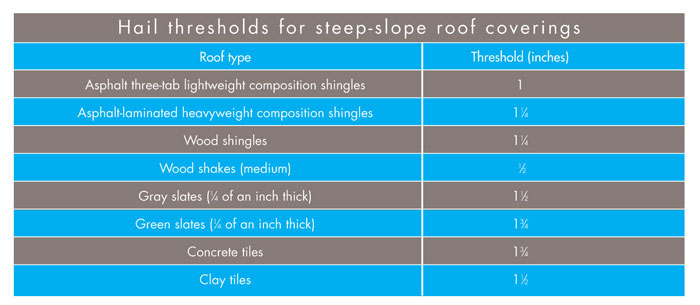Editor's note: Following is the first in a two-part series addressing hail damage to roof systems. The second part, which will focus on low-slope roof systems, will appear in the June issue.
It's springtime—and time for spring storms. Energetic thunderstorms often produce hailstones in their turbulent updrafts that can wreak havoc on roof coverings. According to the National Oceanic and Atmospheric Administration's annual hail summaries, property damage reached an all-time high of $2.4 billion in 2001.
Because of the frequency of hail damage to roof systems, many roofing professionals, insurance professionals and homeowners mistakenly assume a roof system needs to be replaced or repaired following a hailstorm. However, this is not always the case.
To recognize hail damage on steep-slope roof systems, it is helpful to understand finished roof systems' properties and component constituents. Additionally, you should be able to recognize the effects of normal aging on a roof and the effects of various natural perils and inherent manufacturing issues.
Some hail particulars
A single hailstorm can produce hailstones that vary in size, shape and hardness. However, small hailstones are much more common than large hailstones.
Hailstones fall in random patterns with predominant fall direction influenced by wind. Although wind imparts a directional component to hailstones, it generally only minorly contributes to their impact forces.
Hail typically leaves telltale signs where it falls. Roofs may exhibit spatter marks—surface areas where grime, oxide, algae or microorganisms have been cleaned away by hailstone impacts. Spatter marks typically linger for about a year, depending on exposure and climate. The larger the hail, the larger the spatter.
Look for dents in metals. Remember, metals are permanent records of all the hailstorms the metals have endured. Dent sizes in most metals are only general indicators of hailstone size. My company has found the best gauge of specific hailstone size is the dents left by hail in aluminum fins of air-conditioning and HVAC units. A dent's width typically is 80 percent of the hailstone diameter.
A roof system is not functionally damaged by hail unless the roof's watershedding capabilities are diminished or the roof's expected service life is reduced.
Damage thresholds
So what size hail is sufficient to functionally damage steep-slope roof coverings? The answer is: It depends.

The smallest threshold sizes of hail that can damage various steep-slope roof coverings
The figure on page 36 lists the smallest threshold sizes of hail that typically can damage common steep-slope roof coverings. The thresholds, which are the culmination of more than 45 years of laboratory testing with simulated hail and tens of thousands of field inspections, are provided given the following set of assumptions: hard hail, perpendicular impacts, reasonable support, and roof systems in relatively good or midlife condition.
Asphalt shingles
Asphalt shingles, the most common steep-slope roof covering, must be punctured or fractured by hail before they are considered functionally damaged. A puncture or fracture of an asphalt shingle will leave an identifiable mark where granules are dislodged from the shingle's surface. Impact-caused fractures start on a shingle's underside (the region of maximum tensile strain) and propagate toward its topside (granule surface). Therefore, an impact-caused fracture always is detectable on a shingle's underside. Fractures on shingles' undersides often are accompanied by fractures in shingle reinforcements, which diminish shingles' watershedding capabilities.
Some fractures can be seen on a shingle's top surface. In other instances, a fracture may not be obvious on a shingle's top surface but can be felt with your fingertips as a localized soft spot. These soft spots often are referred to as "bruises" because they feel like a bruise on an apple.
A shingle's expected service life can be shortened when granules are dislodged sufficiently to expose the underlying coating asphalt. For shingles in relatively good condition, a hailstone capable of dislodging granules and exposing the coating asphalt fractures the reinforcement and generates a detectable bruise. In other words, if granules are missing from a shingle in good condition, there also will be a fracture.
Shingles that lose enough granules to expose the coating bitumen but do not sustain fractures in their reinforcements typically are already nearing the end of their service lives and are flaking or defective. Because service life has been exceeded or is nearing an end in these conditions, this would not be considered functional damage. The loss of granules is an ongoing process that begins at the time of a shingle's manufacture and is considered normal weathering. Although hail, rain, wind, foot traffic and virtually any other force displace loose granules, granule loss is not considered functional damage.
Wood shingles and wood shakes
The most common steep-slope wood roofing products are manufactured from Western red cedar. The wood's quality is determined by the type of cut (grain) and the type, size and frequency of defects.
Hail can damage wood shingles and wood shakes when it is of sufficient size, hardness and speed to reduce a shingle's or shake's watershedding capability by puncturing or splitting the wood. A hail-caused split has the following characteristics:
- The split is along the wood's grain and accompanied by a sizeable coincident dent.
- A recent split's interior is sheltered from the elements and, when opened, reveals a bright orange color until it has had time to weather.
- The split is sharp-edged and can be made to nearly disappear when butt corners are pushed together.
- Although relatively rare, hail-caused splits can be offset from initiating dents because of support conditions that create cantilevers.
Of course, hail-caused splits are not the only splits you'll see in wood shingles and wood shakes. My company has found more than 30 percent of the finest edge-grain cut wood and 65 percent of flat-grain cut wood split naturally from weathering. A weathering-caused split is the most common split type and has the following attributes:
- It has a V-shaped growth from butt toward head.
- It has a V-shaped cross-section as the wood is water-eroded over time.
- Wood within the split is exposed and weathered gray.
- The split cannot be closed when butt corners are pushed together because wood has been weathered away.
Footfall-caused splits from foot traffic also are frequently seen on wood shingle and wood shake roofs. Footfall-caused splits are identical to hail-caused splits except for one important distinction: Footfall-caused splits do not initiate sizeable surface indentations.
To determine whether a split is caused by hail, examine a wood shingle or wood shake closely. Press on butt corners to expose fractures that are not visible. Conversely, you can push butt corners together to confirm weathering-caused splits.
Worried that a hail-caused impact mark will lead to future splitting? Studies conducted by my company have shown dents and deep gouges in wood caused by hailstone impacts do not create an increased propensity for splitting or deterioration in the future and do not constitute functional damage.
Slate
Slate is rigid compared with most other steep-slope roof coverings. Slate's watershedding capabilities can be reduced when hail punctures, fractures or dents it.
Slate fractures can range from single arcs to multiple fractures radiating from a common impact point, and when substantially weathered, soft slate may simply be crushed. Areas of slate most sensitive to fractures are butt corners and edges. These can be lopped away by fractures in roughly curvilinear forms.
Fractures that expose underlayment or fasteners or create joints that are too wide or spaced too closely are considered functional damage. Near-linear fractures extending across slate usually are the result of foot traffic.
Tile
Similar to slate, concrete and clay tiles are relatively rigid roofing materials. Tile fractures regularly are multiple fractures radiating from a common impact point.
Butt corners and overlays along edges are tiles' most impact-sensitive areas. These can be lopped away by fractures in curvilinear patterns.
Functional damage results when fractures expose underlayment or fasteners or create joints that are too wide or spaced too closely. Fractures in linear forms typically are the result of foot traffic.
An accurate assessment
Hail damage, though often misunderstood, is not mysterious. Once identified, it can be quantified and an economic assessment made whether to repair individual locations of damaged roofing materials or replace the entire roof system.
Scott J. Morrison, P.E., is principal engineer for Haag Engineering Co., Irving, Texas.


